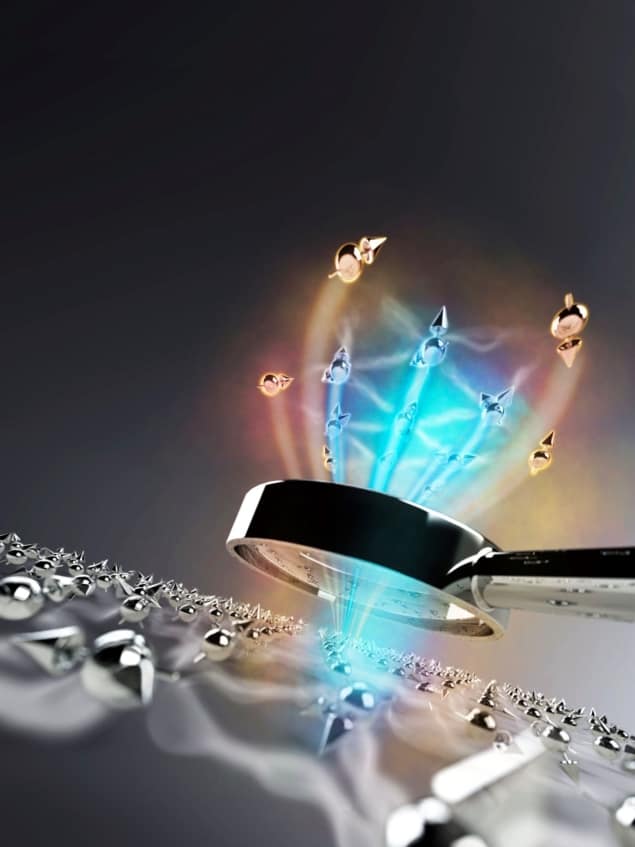Quantum simulator visualizes large-scale entanglement in materials
14 Dec 2023
How entangled is it? The researchers obtained temperature profiles of their system showing that particles that interact strongly are “hot” (red) and those that interact little are “cold” (blue). Entanglement is greatest when interactions are strong. (Courtesy: Helene Hainzer)
Physicists in Austria have found a quick and efficient way of extracting information on a quantum material’s large-scale entanglement structure thanks to a 50-year-old theorem from quantum field theory. The new method could open doors in fields such as quantum information, quantum chemistry or even high-energy physics.
Quantum entanglement is a phenomenon whereby the information contained in an ensemble of particles is encoded in correlations among them. This information cannot be accessed by probing the particles individually, and it is an essential feature of quantum mechanics, one that clearly distinguishes the quantum from the classical world. As well as being pivotal for quantum computing and quantum communication, entanglement heavily influences the properties of an emerging class of exotic materials. A deeper understanding of it could therefore help scientists understand and solve problems in materials science, condensed-matter physics and beyond.
The problem is that learning about the internal entanglement of a large number of entangled particles is notoriously hard, since the complexity of the correlations increases exponentially with the number of particles. This complexity makes it impossible for a classical computer to simulate materials made from such particles. Quantum simulators are better equipped for this task, as they can represent the same exponential complexity as the target material they are simulating. However, extracting the entanglement properties of a material with standard techniques still requires an intractably large number of measurements.
Quantum simulator
In their new, more efficient method for evaluating the strength of a system’s entanglement, researchers from the University of Innsbruck and the nearby Institute of Quantum Optics and Quantum Information (IQOQI) interpreted entanglement strength in terms of a local temperature. While highly entangled regions of the quantum material appear “hot” in this method, weakly entangled regions appear “cold”. Crucially, the exact form of this locally varying temperature field is predicted by quantum field theory, enabling the team to measure temperature profiles more efficiently than was possible with previous methods.
To simulate an entangled quantum material, the Innsbruck-IQOQI team used a system of 51 40Ca+ ions held in place inside a vacuum chamber by the oscillating electric field of a device called linear Paul trap. This setup allows each ion to be individually controlled and its quantum state read out with high accuracy. The researchers could quickly determine the right temperature profiles by placing a feedback loop between the system and a (classical) computer that is constantly generating new profiles and is comparing them with the actual measurements in the experiment. They then made measurements to extract properties such as the system’s energy. Finally, they investigated the internal structure of the system’s states by studying the “temperature” profiles, which enabled them to determine the entanglement.
Hot and cold regions
The temperature profiles the team obtained show that regions that are strongly correlated with surrounding particles can be considered “hot” (that is, highly entangled) and those that interact very little can be considered “cold” (weakly entangled). The researchers also confirmed, for the first time, predictions of quantum field theory as adapted to ground states (or low temperature states) of materials via the Bisognano-Wichmann theorem, which was first put forward in 1975 as a way of relating certain Lorentz transformations in spacetime to transformations in charge, parity and time. In addition, the method enabled them to visualize the crossover from weakly entangled ground states to strongly entangled excited states of the quantum material.
Team leader Peter Zoller, who holds positions at both Innsbruck and the IQOQI, says that the results and the techniques – quantum protocols running on a quantum simulator – used to obtain them are generally applicable to the simulation of quantum materials. For this reason, he believes they hold broad importance for quantum information science and technology as well as quantum simulation. “For future experiments we [would] like to do this with other platforms and more complicated/interesting model systems,” he tells Physics World. “Our tools and techniques are very general.”READ MORE

Marcello Dalmonte, a physicist at the Abdus Salam International Centre for Theoretical Physics in Italy who was not involved in the research, calls the results “a true ground-breaker”. In his view, the method brings our experimentally testable understanding of entanglement to a new level by unveiling its full complexity. He also thinks the technique will improve our understanding of the relationship between entanglement and physical phenomena, and is excited by the possibility of using it to solve key questions in theoretical physics, such as reaching a better understanding of the operator entanglement structure for mixed states. Another possible area to explore might be the mutual entanglement between chunks of matter, though Dalmonte adds that this would require further improvements to the protocol, including boosting its scalability.
The research is described in Nature.
from physicsworld.com 28/12/2023

Δεν υπάρχουν σχόλια:
Δημοσίευση σχολίου